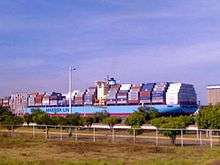Port of Lázaro Cárdenas
The Port of Lázaro Cárdenas (Spanish: [ˈlasaɾo ˈkaɾðenas] (![]()
| Port of Lázaro Cárdenas | |
|---|---|
 Container ship in port. | |
| Location | |
| Country | Mexico |
| Location | Lázaro Cárdenas, Michoacán |
| Coordinates | 17°55′37″N 102°10′08″W |
| UN/LOCODE | MXLZC[1] |
| Details | |
| Owned by | Port Authority of Lázaro Cárdenas |
| Type of harbor | Natural/Artificial |
| Size of harbor | 160 ha (0.62 sq mi) |
| Land area | 25 ha (0.097 sq mi) |
| Size | 185 ha (0.71 sq mi) |
| Available berths | 15 |
| Wharfs | 22 |
| Statistics | |
| Vessel arrivals | 1,522 vessels (2012)[2] |
| Annual cargo tonnage | 30,671,996 tonnes (2012) [2] |
| Annual container volume | 1,242,777 TEU's (2012)[2] |
| Website puertolazarocardenas.com.mx | |
History
In November 2003, the Mexican navy seized the port from criminal gangs.[3]
Description
Lázaro Cárdenas is home to a deep-water seaport that handles container, dry bulk, and liquid cargo. The port currently has one container terminal, which handled 1.24 million TEU in 2012, and has a total capacity of 2.2 million TEU annually.[2] APMT has plans to build an additional container terminal that would bring the port's capacity to 3.4 million TEU in 2015 and 6.5 million TEU in 2020.[4] Cargo moves to and from the port by road and rail equally, with rail service provided exclusively by Kansas City Southern de México. The port is expected to become a major container facility due to congestion at the U.S. ports of Los Angeles and Long Beach and its relative proximity to major cities such as Chicago, Kansas City, and Houston. In preparation for the port's increased capacity, railway and highway infrastructure running north–south through the center of Mexico has been upgraded in recent years to handle the anticipated increase in volume of goods bound for the United States using this transportation corridor.[5] If a proposed government-backed Pacific port is built at Punta Colonet, Baja California, goods flowing to U.S. states like Arizona and Nevada could bypass the congested Los Angeles region with closer access to those markets, providing increased competition with Lázaro Cárdenas.[5]
Lázaro Cárdenas is the terminus of the Salamanca-Lazaro Cardenas gas pipeline.[6]
Statistics
In 2012, the Port of Lázaro Cárdenas handled 30,671,996 tonnes of cargo and 1,242,777 TEU's, making the busiest cargo port in Mexico and one of the largest container ports in the country.[2]
| Year | 2004 | 2005 | 2006 | 2007 | 2008 |
|---|---|---|---|---|---|
| RoRo (nr of automobiles) | 0 | 24,923 | 88,669 | 114,276 | 112,457 |
| Liquid bulk* | 932,000 | 919,000 | 1,281,000 | 1,841,000 | 2,275,000 |
| Dry bulk* | 10,165,000 | 12,940,000 | 13,895,000 | 11,234,000 | 5,804,000 |
| Break bulk* | 2,910,000 | 2,785,000 | 2,587,000 | 2,719,000 | 1,809,000 |
| Containers (TEU's) | 43,445 | 132,479 | 160,696 | 270,240 | 524,791 |
| Containers* | 323,000 | 1,030,000 | 1,159,000 | 1,544,000 | 4,240,000 |
| Total*' | 14,330,000 | 17,674,000 | 18,992,000 | 17,693,000 | 20,860,647 |
- * figures in tonnes
Terminals
The port of Lázaro Cárdenas[8] has both public and private terminals specialised in:
Public terminals[8]
- Grain terminal: 15,064 m2 (162,150 sq ft)
- Multi use terminals: 62,889 m2 (676,930 sq ft)
- Container terminals: 634,120 m2 (6,825,600 sq ft)
Private terminals[8]
- Mineral terminal: 60,328 m2 (649,370 sq ft)
- Fluid terminal: 1,783,413 m2 (19,196,500 sq ft)
- Coal terminal: 1,163,408 m2 (12,522,820 sq ft)
- Fertilizer terminal: 1,487,381 m2 (16,010,040 sq ft)
References
- "UNLOCODE (MX) - Mexico". service.unece.org. Retrieved 25 April 2020.
- "Monthly Statistical Report, Cargo, Ships and Passengers" (PDF) (in Spanish). 2012-12-31. Retrieved 2013-01-30.
- "Why Mexican drug-traffickers started smuggling iron ore to China". www.economist.com. The Economist. 9 March 2014. Retrieved 9 March 2014.
- "Competitive Factors for US Midwest Markets". 2012-03-26. Retrieved 2013-01-31.
- "About the Port" (in Spanish). 2009-01-29. Retrieved 2009-01-29.
- "Mexico Pipelines map - Crude Oil (petroleum) pipelines - Natural Gas pipelines - Products pipelines". Theodora.com. Retrieved 2013-11-18.
- "Movimiento Portuario - Historico" (PDF) (in Spanish). Archived from the original (PDF) on 2012-02-20. Retrieved 2009-01-29.
- "Terminals and Facilities". 2009-01-29. Retrieved 2009-01-29.